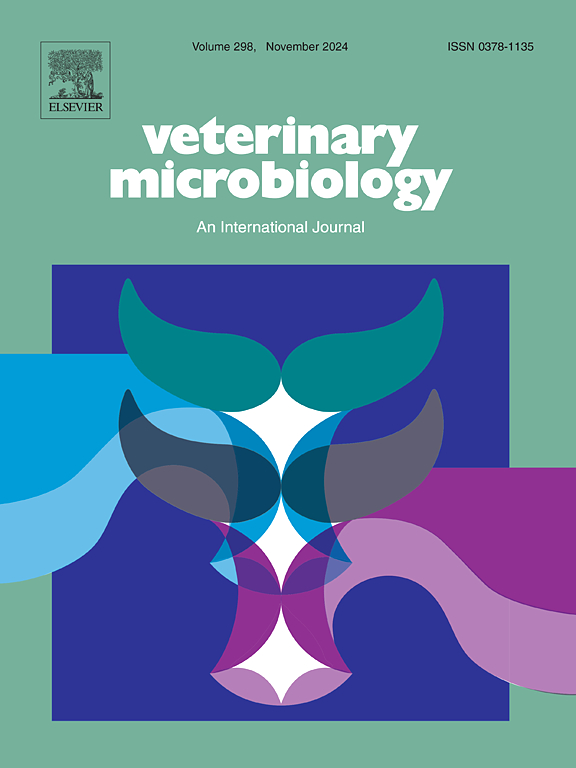Longitudinal and cross-sectional study of Chlamydia serpentis in captive snakes: Insights from two successive outbreaks in a zoological institution
IF 2.7
2区 农林科学
Q3 MICROBIOLOGY
引用次数: 0
Abstract
Among the Chlamydia species known to infect snakes, C. serpentis is a recently described pathogen. A first outbreak of C. serpentis in the snake collection of a zoological institution was documented in 2018. In 2023, a wild-caught asp viper (Vipera aspis) tested positive by PCR for C. serpentis, following introduction with two snakes of the same species that had tested positive in 2018. Real-time PCR analysis was used to detect the presence of C. serpentis in oral/cloacal swabs and tissue samples from snakes, and environmental samples from the terrariums of confirmed infected individuals. A sequential screening of 29 snakes was performed based on disease-risk analysis, with 5/29 (17.2 %) testing positive, including the three asp vipers and two co-housed European long-nosed vipers (Vipera ammodytes), all belonging to the same epidemiological unit. All three snakes treated with 5 mg/kg marbofloxacin intramuscularly daily tested PCR negative following treatment. Comparison of the ompA sequences and MLST profiles of the strains involved in the 2018 and 2023 outbreaks suggests a single source of contamination and unique circulating strain. As in 2018, the origin of the infection remains unknown, but potential sources include persistent infection and/or intermittent shedding among infected snakes from the 2018 outbreak, environmental persistence, or introduction via the newly acquired wild-caught viper. These successive outbreaks provide insights into the epidemiology and dynamics of C. serpentis infections in captive snakes, further supporting the need for integrated management strategies combining medical treatment, environmental decontamination, and epidemiological unit management to minimize cross-contamination and prevent pathogen transmission.
蛇衣原体在圈养蛇的纵向和横断面研究:见解从两个连续爆发的动物机构
在已知感染蛇的衣原体种类中,蛇原体是最近发现的一种病原体。2018年,一家动物机构收集的蛇中首次爆发了C.蛇。2023年,一条野生捕获的毒蛇(Vipera aspis)经PCR检测为C. serentis阳性,此前在2018年引入的两条同一物种的蛇检测呈阳性。采用实时荧光定量PCR方法检测蛇的口腔/肛肠拭子和组织样本以及确诊感染者水族箱的环境样本中是否存在蛇弧菌。基于疾病风险分析对29条蛇进行了顺序筛查,其中5/29(17.2 %)检测呈阳性,包括3条asp蝰蛇和2条共同居住的欧洲长鼻蝰蛇(Vipera ammodytes),均属于同一流行病学单位。每日肌肉注射5 mg/kg马氟沙星后,三条蛇的PCR检测均为阴性。2018年和2023年疫情中涉及的菌株的ompA序列和MLST谱的比较表明,污染源单一,流行菌株独特。与2018年一样,感染的来源仍然未知,但潜在的来源包括2018年疫情中受感染蛇的持续感染和/或间歇性脱落、环境持续性或通过新获得的野生捕获毒蛇引入。这些连续的暴发为了解圈养蛇中C.蛇感染的流行病学和动态提供了见解,进一步支持了将医疗、环境净化和流行病学单位管理相结合的综合管理战略的必要性,以尽量减少交叉污染并防止病原体传播。
本文章由计算机程序翻译,如有差异,请以英文原文为准。
求助全文
约1分钟内获得全文
求助全文
来源期刊

Veterinary microbiology
农林科学-兽医学
CiteScore
5.90
自引率
6.10%
发文量
221
审稿时长
52 days
期刊介绍:
Veterinary Microbiology is concerned with microbial (bacterial, fungal, viral) diseases of domesticated vertebrate animals (livestock, companion animals, fur-bearing animals, game, poultry, fish) that supply food, other useful products or companionship. In addition, Microbial diseases of wild animals living in captivity, or as members of the feral fauna will also be considered if the infections are of interest because of their interrelation with humans (zoonoses) and/or domestic animals. Studies of antimicrobial resistance are also included, provided that the results represent a substantial advance in knowledge. Authors are strongly encouraged to read - prior to submission - the Editorials (''Scope or cope'' and ''Scope or cope II'') published previously in the journal. The Editors reserve the right to suggest submission to another journal for those papers which they feel would be more appropriate for consideration by that journal.
Original research papers of high quality and novelty on aspects of control, host response, molecular biology, pathogenesis, prevention, and treatment of microbial diseases of animals are published. Papers dealing primarily with immunology, epidemiology, molecular biology and antiviral or microbial agents will only be considered if they demonstrate a clear impact on a disease. Papers focusing solely on diagnostic techniques (such as another PCR protocol or ELISA) will not be published - focus should be on a microorganism and not on a particular technique. Papers only reporting microbial sequences, transcriptomics data, or proteomics data will not be considered unless the results represent a substantial advance in knowledge.
Drug trial papers will be considered if they have general application or significance. Papers on the identification of microorganisms will also be considered, but detailed taxonomic studies do not fall within the scope of the journal. Case reports will not be published, unless they have general application or contain novel aspects. Papers of geographically limited interest, which repeat what had been established elsewhere will not be considered. The readership of the journal is global.
 求助内容:
求助内容: 应助结果提醒方式:
应助结果提醒方式:


